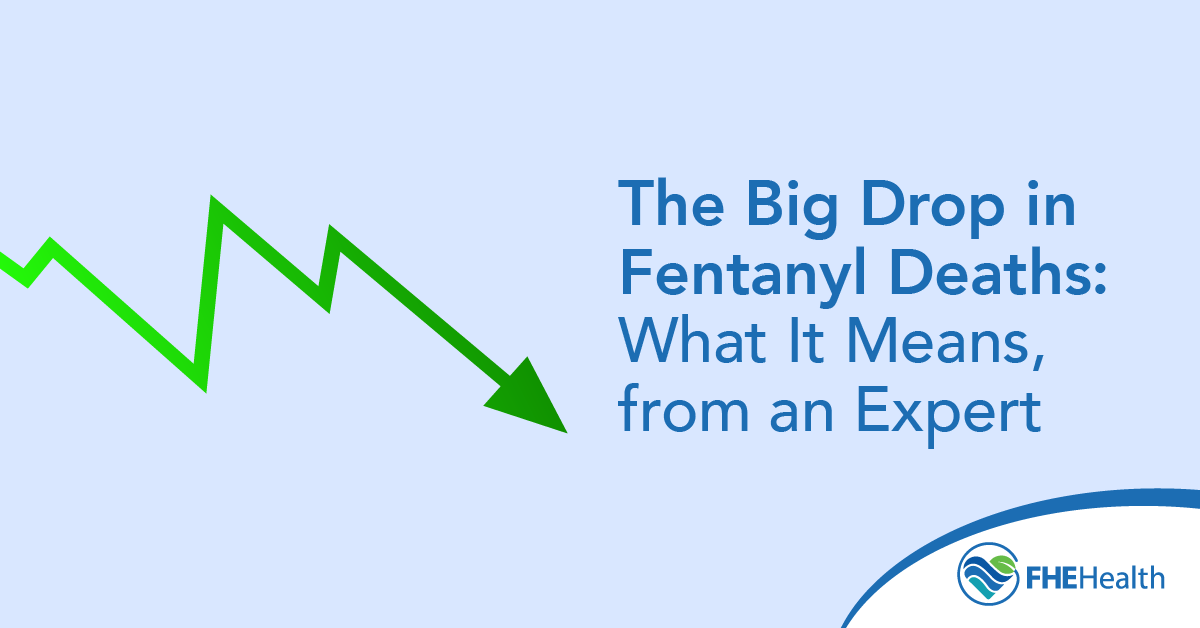
Fentanyl deaths are down substantially in every state and the District of Columbia. That is the finding of researchers at the University of North Carolina at Chapel Hill. They analyzed overdose records from the Centers for Disease Control and Prevention and discovered to their great surprise that fatal overdoses from fentanyl had plummeted by 30.6 percent. A March 2025 report by NPR described this promising finding in detail, with the help of experts who shared their interpretations of what it might mean.
Meanwhile, we decided to do some expert analysis of our own and reached out to FHE Health’s Chief Clinical Officer, Dr. Beau A. Nelson, DBH, LCSW. What do these latest statistics tell us about this drop in deaths from fentanyl? Can we expect to see fentanyl deaths plummet, or is this more likely a short-term trend? And, of the many theories that seek to account for this drop in overdoses, which are the most convincing?
In the below Q&A, Dr. Nelson provides insights into these and other questions, shedding light on this potentially seismic moment in the fight to end the opioid epidemic….
What the Stats Reveal About This Trend
Q: What do these latest statistics tell us about the drop in fentanyl-related deaths and what it means?
A: The drop in fentanyl-related deaths is encouraging and suggests that some of our national and local strategies may finally be gaining traction. It signals a potential shift in the crisis, but we need to interpret it thoughtfully. This is progress, not victory.
Q: How significant is this drop? Are we seeing a meaningful shift here or just a short-term trend, do you think?
A 30 percent drop is statistically significant and hopeful, but we’ve seen brief dips before. It’s too early to call this a long-term shift. Sustained declines over multiple years would confirm that we’re turning a corner. The fact is people are still suffering and self-medicating, although it may not be opioids. The jury is still out for the long-term meaning.
What Factors Have Most Contributed to the Trend
Q: What factors do you think have most contributed to this sizable drop in fentanyl deaths?
I’d like to think it is a result of harm reduction efforts, expanded naloxone access, increased public awareness, and wider distribution of test strips.
Q: Theories abound as to what explains the drop in fentanyl deaths. Some say we’re only now beginning to see the end of the effects of the COVID pandemic, which caused overdose rates to soar, starting in 2020. Others believe that, at a rate of 110,000 drug overdose deaths per year, many of the most vulnerable have already (tragically) died. But there are other more empowering theories too, that suggest certain public health policies are having an impact. Are any of these theories more convincing for you, and why?
Several theories are plausible. I find the impact of expanded harm reduction tools and greater public access to naloxone particularly compelling — they provide real-time, life-saving interventions. But a coordinated effort across prevention, treatment, and supply reduction is likely driving the change.
Q: What needs to happen to ensure this decline continues and doesn’t reverse?
We need to double down on what’s working, such as to expand access to evidence-based treatment, reduce stigma, support harm reduction programs, and ensure people have the tools to survive and recover. Complacency is the biggest threat to sustained progress.
Treatment for Opioid Use Disorders – Progress and Challenges
Q: How has access to treatment for opioid use disorders changed in recent years?
Thankfully, access has improved, but we are still a long way off from the end goal. Through options like telehealth treatment, expanded MAT (medication-assisted treatment), and changes in prescribing regulations, we are making progress. But access is still uneven as many areas remain underserved for substance use disorders and mental health precursors to use, and unfortunately stigma continues to be a barrier.
Q: What are the challenges in treating opioid use disorders?
Stigma, limited access to care, inconsistent insurance coverage, and lack of low-cost, long-term treatment options are major hurdles. We’re treating a complex brain disease that also intersects with so many issues, like trauma, poverty, and mental health. There’s not a one-size-fits-all solution. Each community must address its unique needs, given its resources and resolve.
Advice for Families with Loved Ones Who Are Struggling
Q: What advice would you give someone whose loved one is struggling with opioids?
Don’t wait — reach out for help. Get educated, find support yourself, and do what you can to connect your loved one to treatment. Compassion, boundaries, and professional guidance can be a lifeline to getting help for everyone impacted by substance use, which is more than treatment just for the user.






